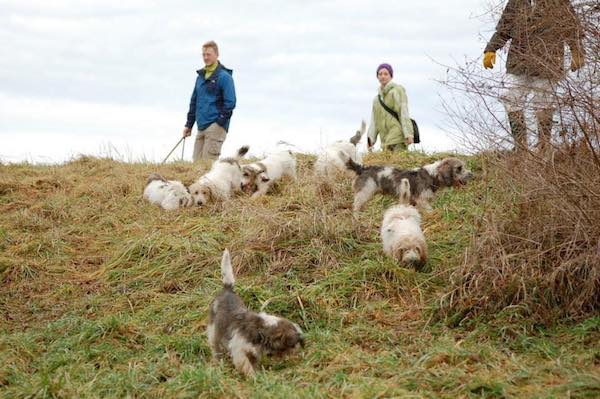
In 2001, PBGV (Petit Basset Griffon Vendéen) owners and their dogs from all across the country gathered in Concord, North Carolina for the first Hunting Instinct Test because this merry little soul who loves to dig and bark also loves to hunt, and still does in some parts of the world.
They are best suited for rabbit (their primary game here in the US), but over in Europe, they are used on boar and roe. They hunt best in packs, but depending upon the hound, can be worked individually or as a couple or brace. Each dog has their own role in the pack: One dog might be good at finding a rabbit in deep cover and flush it out, while another is better at waiting in lighter cover for the rabbit to pop out. Some at least one PBGV owner we know of has even gone out with Skycastle Hounds to hunt, though the dogs have two different approaches and styles to hunting.
As an aside, Skycastle French Hounds are descended from the first hounds brought to this country by Elizabeth Streeter in the ’80’s. She acquired her hounds from an experienced hunter and PBGV breeder in France, and most of those hounds were already field trained. Puppies are trained to horn and voice, and are taught the subtleties of hunting by the older hounds in the pack. One Our PBGV contact on this topic usually takes out five couple (10 hounds, they are always counted in couples) of hounds, and as mentioned above, each hound finds its own place/job in the pack. They range from the alpha hound, the dog who has everything: Nose, drive and concentration; the beta hound honors the lead hounds and has the ability to keep the drive on scent going. The gamma or ‘C’ hound is tied to the scent line and will follow accurately. These three types are all needed as part of a pack. The ‘C’ hound is especially helpful when the line is confused by other scent, as it can show the huntsman exactly where the line was lost. It’s fascinating to see how well they compliment each other during a hunt.
Many PBGV owners “hunt” by participating in “hunt tests” or practicing. These take place in fully fenced fields and woods, usually at beagle clubs, so there is no chance of losing a dog. Actually, some owners use GPS collars just to make it easier to see what the dogs are doing, and to collect them up when everyone else is done (quite often before the dogs are ready to quit!)
Much of the information here was gleaned by comments made during our Purebred of Interest featuring the PBGV, and our special thanks to Logan Ann Luffel and Bruce Toenjes.
